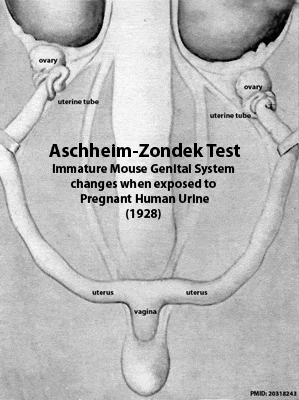Pregnancy Test
| Embryology - 16 Apr 2024 |
|---|
| Google Translate - select your language from the list shown below (this will open a new external page) |
|
العربية | català | 中文 | 中國傳統的 | français | Deutsche | עִברִית | हिंदी | bahasa Indonesia | italiano | 日本語 | 한국어 | မြန်မာ | Pilipino | Polskie | português | ਪੰਜਾਬੀ ਦੇ | Română | русский | Español | Swahili | Svensk | ไทย | Türkçe | اردو | ייִדיש | Tiếng Việt These external translations are automated and may not be accurate. (More? About Translations) |
| Educational Use Only - Embryology is an educational resource for learning concepts in embryological development, no clinical information is provided and content should not be used for any other purpose. |
Introduction
The first of prenatal diagnostic tests. Through history there were a number of supposedly diagnostic tests to determine early pregnancy, the most obvious was the absence of an ongoing menstrual cycle in women of reproductive age. It was not until the early 20th century that the first clinical maternal urine test was developed.[1] A complicated test requiring analysis of changes induced in the immature mouse genital system by hormones present in the maternal urine. The test was replaced by a urine test with either the rabbit (Friedman modification[2]) showing similar changes or frog (Xenopus), that could be induced to lay eggs by similar urine effects. In the 1960's an immunological test for human chorionic gonadotropin (hCG) in either maternal urine or blood led to development in the late 1970's of home pregnancy kits that became simple one step tests in the late 1980's.
See the external link to 2003 online NIH summary, "The Thin Blue Line" and the 2004 review[3] on the history of the home pregnancy test.
Note that there are a number of pathological conditions, such as endocrine tumours and hydatidiform moles, that can also mimic the detected hormonal changes.
- Links: Menstrual Cycle | Week 2 | Implantation | Placenta Development | Pregnancy Test | Hydatidiform Mole | Human Chorionic Gonadotropin
Some Recent Findings
|
| More recent papers |
|---|
|
This table allows an automated computer search of the external PubMed database using the listed "Search term" text link.
More? References | Discussion Page | Journal Searches | 2019 References | 2020 References Search term: Pregnancy Test <pubmed limit=5>Pregnancy Test</pubmed> |
History
- 1928 - Bernhard Zondek and Selman Aschheim procedure that measured the increase in gonadotrophic substance in the urine of a pregnant woman.[1][6]
- Immature mice injection with urine led to ovarian changes after a few days.
- Xenopus clawed frog replaced mice, injection with urine stimulated the females to lay eggs that were easily seen the next day.
- 1960s - immunological tests for chorionic gonadotropin.
- 1972 - Research on hCG at NIH by Judith Vaitukaitis and Griff Ross.
- 1978 - USA first home pregnancy test kits available.
- 1988 - first “one step” test, Clearblue Easy, a blue stripe appeared to indicate pregnancy.

Aschheim-Zondek Test (1928) |

Rabbit Xenopus clawed frogs |

Judith Vaitukaitis and Griff Ross (c1971) |
Pregnancy Testing in Medicine
The urine test can be an indicator of an existing pregnancy, but does not exclude a pregnancy that has not reached the implantation stage, or even a very early adplantation stage (GA week 3). This test is often used in consultation with information on sexual history and the menstrual cycle, the last menstrual period (LMP).
There are a number of medical procedures and medications that are contraindicated for pregnant women. This can form part of a discussion or screening process prior to the procedure or prescription. This is also an issue in some medical procedures on women of reproductive age that require anaesthesia,[7] see also UK NICE Guideline - section 5.18). A second issue relates to the preoperative pregnancy testing of minors, regulations for this circumstance may differ between countries.
A immunoradiometric assay for human chorionic gonadotropin (hCG) in urine identified that 10% of clinical pregnancies were undetectable on the first day of missed menses. The same test 1 week after the first day of the missed period, the test identified 97% of clinical pregnancies.[8]
- Links: Menstrual Cycle | Abnormal Development - Drugs | Australian Drug Categories | USA Drug Categories
References
- ↑ 1.0 1.1 Aschheim, S., and Zondek, B., Klin. Wschr., 7 8, 1401 (1928).
- ↑ Friedman, M.H. Mechanism of ovulation in the rabbit: II. Ovulation produced by the injection of urine from pregnant women. Am J Physiol. 1929 90:617-622. PDF
- ↑ <pubmed>15838116</pubmed>
- ↑ <pubmed>23040127</pubmed>
- ↑ <pubmed>22447994</pubmed>
- ↑ <pubmed>18741243</pubmed>
- ↑ <pubmed>22273990</pubmed>
- ↑ <pubmed>11594902</pubmed>
Reviews
<pubmed></pubmed> <pubmed></pubmed> <pubmed>22149742</pubmed>
Articles
<pubmed></pubmed> <pubmed></pubmed> <pubmed></pubmed> <pubmed>19395437</pubmed> <pubmed>19100935</pubmed> <pubmed>1117063</pubmed> <pubmed>4823920</pubmed>
Search Pubmed
Search Pubmed: Pregnancy Test | hCG
Search Bookshelf: Pregnancy Test | Human Chorionic Gonadotropin
External Links
External Links Notice - The dynamic nature of the internet may mean that some of these listed links may no longer function. If the link no longer works search the web with the link text or name. Links to any external commercial sites are provided for information purposes only and should never be considered an endorsement. UNSW Embryology is provided as an educational resource with no clinical information or commercial affiliation.
- USA - NIH A thin blue line - The History of the Pregnancy Test Kit | Timeline
- USA - Womens Health http://womenshealth.gov/publications/our-publications/fact-sheet/pregnancy-tests.cfm#a Pregnancy tests fact sheet]
- Australia - NSW Health Pregnancy
- UK - National Health Service (NHS) National Institute for Clinical Health and Excellence (NICE) Preoperative Tests The use of routine preoperative tests for elective surgery guidelines. PDF
Glossary Links
- Glossary: A | B | C | D | E | F | G | H | I | J | K | L | M | N | O | P | Q | R | S | T | U | V | W | X | Y | Z | Numbers | Symbols | Term Link
Cite this page: Hill, M.A. (2024, April 16) Embryology Pregnancy Test. Retrieved from https://embryology.med.unsw.edu.au/embryology/index.php/Pregnancy_Test
- © Dr Mark Hill 2024, UNSW Embryology ISBN: 978 0 7334 2609 4 - UNSW CRICOS Provider Code No. 00098G


